Gigabyte Z77X-UP7 Review: OC Oriented Orange Overkill
by Ian Cutress on March 1, 2013 10:30 AM EST- Posted in
- Motherboards
- Intel
- Gigabyte
- Z77
Dealing with PLX 8747 Chips and PCIe Lane Layouts
The Z77 chipset specification allows Ivy Bridge CPUs to utilize the 16 PCIe 3.0 lanes in very specific layouts – x16, x8/x8, or x8/x4/x4. In order to do anything else (including 4-way), we have to put in a PCIe 3.0 switch – and the one in use on motherboards that want this functionality is the PLX 8747, which we covered in great detail back in August 2012. The upside of this chip is that for 8 or 16 lanes in, we get 32 lanes out, which can be distributed however the motherboard manufacturer wants. The downside of using this chip however is a small amount of overhead, causing a minor drop in frame rates. For the Gigabyte Z77X-UP7, we get the following configuration:
The UP7 involves a switch which allows the user to have access to a single PCIe 3.0 x16 slot without even touching the PLX chip. However the moment the user wants to add in another card, we can migrate to the orange slots via the PLX chip and maximize the bandwidth it offers. This gives five different configurations:
One card: x16 or x16 via PLX
Two card: x16/x16 via PLX
Three card: x8/x8/x16 via PLX
Four card: x8/x8/x8/x8
In this review I used the opportunity to look at our normal benchmark suite and see how much overhead the PLX chip actually affords to the motherboards that use it.
Metro2033
Metro2033 is a DX11 benchmark that challenges every system that tries to run it at any high-end settings. Developed by 4A Games and released in March 2010, we use the inbuilt DirectX 11 Frontline benchmark to test the hardware at 2560x1440 with full graphical settings. Results are given as the average frame rate from 4 runs.
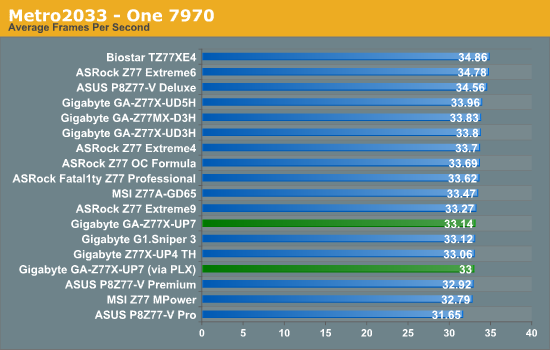
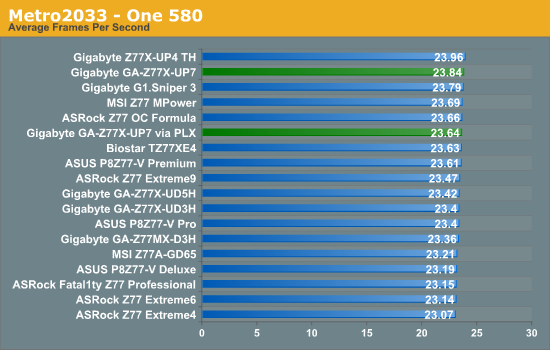
On the PLX front, the chip reduced the single AMD frame rate from 33.14 FPS to 33.00 FPS, a 0.415% decrease. On the NVIDIA side, it reduced our frame rate from 23.84 FPS to 23.64 FPS, a 0.839% decrease. Both of these are nothing much to shout about, especially given the previous NF200 on X58 was a decrease of ~2% performance. Compared to other Z77 motherboards, the UP7 takes advantage of the efficiency we saw in the CPU throughput benchmarks.
Dirt 3
Dirt 3 is a rallying video game and the third in the Dirt series of the Colin McRae Rally series, developed and published by Codemasters. Using the in game benchmark, Dirt 3 is run at 2560x1440 with Ultra graphical settings. Results are reported as the average frame rate across four runs.
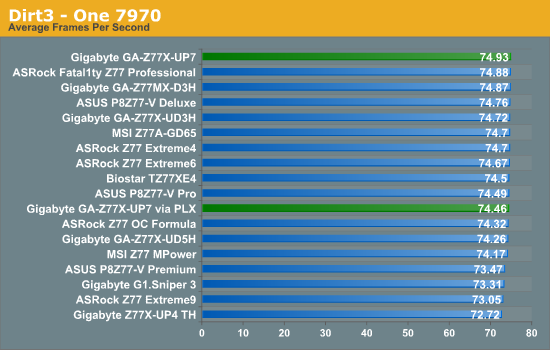
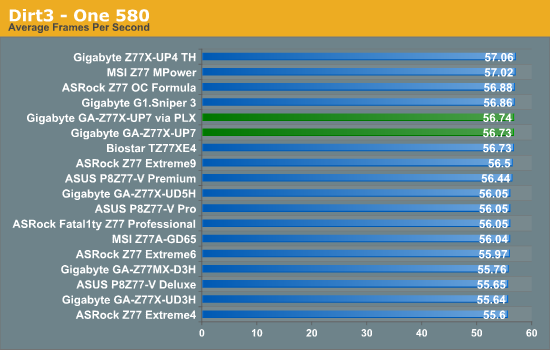
Again the PLX chip causes a minor hit to overall performance, as shown by the 1.97% drop on single card AMD (74.93 FPS to 73.46 FPS), but not so on NVIDIA (56.73-56.74 FPS) both with and without the PLX.
Other Benchmarks
As part of an upcoming update in our motherboard testing, we are moving towards newer drivers, and adding another couple of games to the test bed – Civilization V and Sleeping Dogs, both at 2560x1440 and all the graphical options turned right up. As we are not complete with this testing, we do not have any substantial tables to look through, though I do have Single GPU results on Catalyst 13.1 and NVIDIA 310.90 drivers for these games:
Civilization V:
- 86.43 FPS on HD7970
- 81.62 FPS on HD7970 via PLX
- 82.22 FPS on GTX580
- 80.40 FPS on GTX580 via PLX
Sleeping Dogs:
- 28.20 FPS on HD7970
- 27.98 FPS on HD7970 via PLX
- 16.10 FPS on GTX580
- 16.05 FPS on GTX580 via PLX
On all fronts the PLX chip causes a minor hit:
- Civ V: 5.57% on HD7970, 2.21% on GTX580
- Sleeping Dogs: 0.80% on HD7970, 0.31% on GTX580


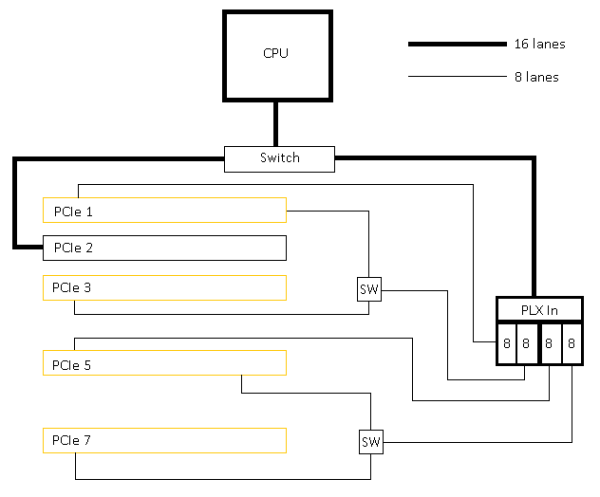








41 Comments
View All Comments
IanCutress - Friday, March 1, 2013 - link
This is an 1155 product, as shown by the fact that it uses the Z77 chipset and I use the i7-3770K to test it. The original OC board was 1366.sherlockwing - Friday, March 1, 2013 - link
What are you smoking, this board is called Z77X-UP7, it is a LGA1155 Z77 board. Where did you get LGA1366 from?dawp - Friday, March 1, 2013 - link
probably from the X58A-OC reference in the article.Samus - Friday, March 1, 2013 - link
Don't hate.xdunpealx - Friday, March 1, 2013 - link
580s? who no 660 or 660ti or even 670s?sna2 - Friday, March 1, 2013 - link
Hi ,we all know this PLX is not real .. the CPU itself supports fixed number of PCIe lanes ... the PLX switches between them thats all ..
If you want to spend that amount of money on a motherboard , then just get an LGA 2011 CPU with C606 or X79 chipset ..
what is the point of all this ? any one who wants 3 or 4 ways SLI , can pay for the LGA 2011 CPU , actually this motherboard is more expensive than the X79 ones.
ANAND , we need you to test PLX VS no PLX performance !
THANKS !
IanCutress - Sunday, March 3, 2013 - link
Hi sna2,If you would direct your attention to:
(a) the GPU results page where I showcase PLX vs. no PLX performance on a single GPU and
(b) my initial discussion on the PLX chip (http://www.anandtech.com/show/6170) where we discuss what the advantages and disadvantages to how the PLX chip actually works.
Yes overall the lanes are limited to 16 upstream and downstream to the GPU, but when dealing with multi-GPU configurations, most data transfer between GPUs (important for gaming and compute) via the PLX, not via the CPU, making the increased lane count between the GPUs more important than the upstream/downstream via the CPU.
Without the PLX, manufacturers are limited to x8/x4/x4 GPU setups with Ivy Bridge CPUs, where compute platforms, some gaming setups, or even a mix with RAID cards and sound cards need the lane allocation to work the way the user wants.
Ian
CNP-Keythai - Saturday, March 2, 2013 - link
I think the board looks cool, price is good too. Would recommend it.kmmatney - Saturday, March 2, 2013 - link
I'm going to buy it just for use around Halloween.Beenthere - Saturday, March 2, 2013 - link
The "orange" in addition to making this mobo look like a Halloween joke... increase sales to the technically challenged. When you hear people talk about how they like the color of the hardware box, RAM, PSU, mobo, etc. it's because they have missed the plot all together.